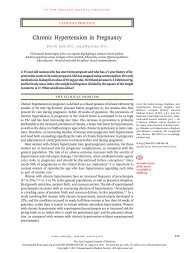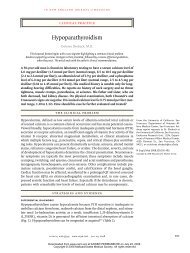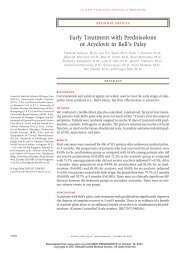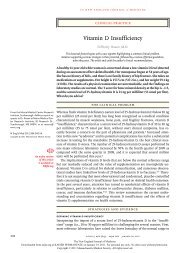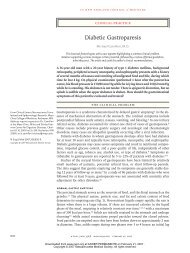Cervical radiculopathy - enotes - Q-Notes for Adult Medicine
Cervical radiculopathy - enotes - Q-Notes for Adult Medicine
Cervical radiculopathy - enotes - Q-Notes for Adult Medicine
You also want an ePaper? Increase the reach of your titles
YUMPU automatically turns print PDFs into web optimized ePapers that Google loves.
clinical practiceossification of the posterior longitudinal ligament.The combination of CT with the intrathecal administrationof contrast material (CT myelography)provides accuracy similar to 36 and possibly superiorto 37 that of MRI, but its invasive nature makesMRI preferable in most cases. Technetium and galliumbone scans are very seldom indicated, except inrare cases in which cancer or infection is suspectedin multiple sites and MRI cannot be readily per<strong>for</strong>medor is impractical.electrodiagnostic studiesNeedle electromyography and nerve-conductionstudies can be helpful when the patient’s historyand physical examination are inadequate to distinguishcervical <strong>radiculopathy</strong> from other neurologiccauses of neck and arm pain. Typically, abnormalinsertional activity, including positive sharp-wavepotentials and fibrillation potentials, is present inthe limb muscles of the involved myotome withinthree weeks of the onset of nerve compression. 38Examination of the paraspinal muscles increasesthe sensitivity of the test, since insertional activitycan be seen as early as 10 days after the nerve injury.In addition, the presence of abnormal findings inparaspinal muscles differentiates cervical <strong>radiculopathy</strong>from brachial plexopathy.treatmentNonsurgical ManagementThe main objectives of treatment are to relievepain, improve neurologic function, and prevent recurrences.39 None of the commonly recommendednonsurgical therapies <strong>for</strong> cervical <strong>radiculopathy</strong>has been tested in randomized, placebo-controlledtrials. Thus, recommendations derive largely fromcase series and anecdotal experience. The preferencesof patients should be taken into account indecision making.On the basis of anecdotal experience, analgesicagents, including opioids and nonsteroidal antiinflammatorydrugs, are often used as first-line therapy.In patients with acute pain, some physicians advocatea short course of prednisone (<strong>for</strong> example,starting at a dose of 70 mg per day and decreasingby 10 mg every day). 39 This practice is supportedonly by anecdotal evidence, however, and is associatedwith potential risks.Retrospective 40,41 and prospective 42,43 cohortstudies have reported favorable results with translaminarand trans<strong>for</strong>aminal epidural injections ofcorticosteroids, with up to 60 percent of patientsTable 2. Physical Findings Associated with Myelopathy.FindingsHyperreflexia; hypertonia; clonus of the ankle, knee, or wrist; pathologicalreflexes or signs, such as the Babinski sign, Hoffmann’s sign (flexionand adduction of the thumb when the examiner flexes the terminalphalanx of the long finger), and Lhermitte’s sign (a sensationof electrical shock radiating down the spine, precipitated by neckflexion)Clinical grading*MildSensory symptoms; subjective weakness; hyperreflexia (with or withoutHoffmann’s sign or the Babinski sign); no functional impairmentModerateObjective motor or sensory signs (a score of >4 out of 5 on the MedicalResearch Council scale); either no or mild functional impairment(e.g., mild slowing of gait)SevereObjective motor or sensory signs with functional impairment(e.g., hand weakness, unsteady gait, sphincter disturbance)* Clinical grading is per<strong>for</strong>med on the basis of the extent of symptoms, signs,and functional impairment.reporting long-term relief of radicular and neckpain and a return to usual activities. However, complicationsfrom these injections, although rare, canbe serious and include severe neurologic sequelaefrom spinal cord or brainstem infarction. 44 Giventhe potential <strong>for</strong> harm, placebo-controlled trials areurgently needed to assess both the safety and theefficacy of cervical epidural injections.Some investigators have advocated the use ofshort-term immobilization (less than two weeks)with either a hard or a soft collar (either continuouslyor only at night) to aid in pain control. 45 Useof a cervical pillow during sleep has also been recommended.However, data are needed to assess thebenefits of these approaches.<strong>Cervical</strong> traction consists of administering adistracting <strong>for</strong>ce to the neck in order to separatethe cervical segments and relieve compression ofnerve roots by intervertebral disks. Various techniques(supine vs. sitting; intermittent vs. sustained;motorized or hydraulic vs. an over-the-door pulleywith weights) and durations (minutes vs. up to anhour) have been recommended. 46,47 However, asystematic review stated that no conclusions couldbe drawn about the efficacy of cervical traction becauseof the poor methodologic quality of the availabledata. 48 Exercise therapy — including activerange-of-motion exercises and aerobic conditioning(walking or use of a stationary bicycle), followedby isometric and progressive-resistive exercises —is typically recommended once pain has subsidedn engl j med 353;4 www.nejm.org july 28, 2005395Downloaded from www.nejm.org at KAISER PERMANENTE on July 28, 2005 .Copyright © 2005 Massachusetts Medical Society. All rights reserved.







